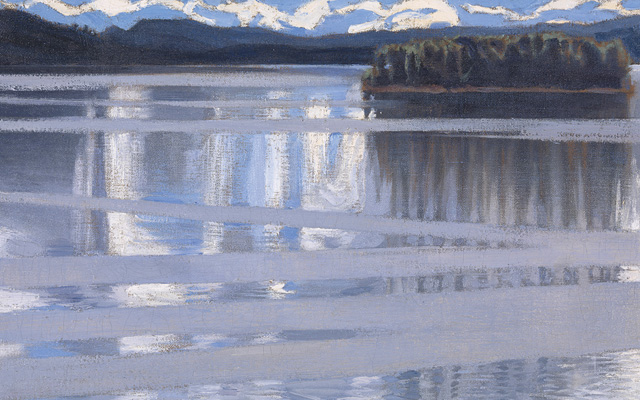Exhibition review: Soundscapes at the National Gallery
Harmony or dischord?

Three years ago (Country Life, March 7, 2012), I wrote about the ways in which some painters deliberately insert sounds as well as visual images into our minds. I suggested that sound is very frequently met with in post-Renaissance and post-Reformation painting, particularly in Flanders and the Netherlands, but also in the work of later artists as diverse as Courbet, Turner and Maggi Hambling. For the greatest enjoy-ment, we should learn to use the mind’s ear as well as its eye.
Now, in its latest show, the National Gallery has taken up the idea, at least in part. Seven sound artists and musicians two working in partnership have each been commissioned to create a ‘soundscape’ for a painting of their choice. Visitors make their way through a warren of darkened, sound-isolated spaces in which to look and listen.
We start with Akseli Gallen-Kallela’s irenic 1905 painting of Lake Keitele in central Finland, its silver-blue surface scratched by the wind. This is a natural choice for Chris Watson, a musician and composer as well as one of the world’s top wildlife recorders (Country Life, February 13, 2013). He has won plaudits working on David Attenborough’s television series. As well as forest birds and cawing ravens, his soundscape incorporates the melodic, echoing calls with which the local Sami people communicate with their ancestors.
Next is Holbein’s Ambassadors, inspiration for Air on a Broken String by Susan Philipsz, who creates ‘installations that explore the psychological and sculptural potential of sound’. Here, the broken string on the painted lute difficult to see in the subdued lighting is one of many symbols of discord in the picture and is evoked by removing one string of the violin whose layered tones are broadcast through three speakers. The aim is an undefined atmosphere of tension.
For Antonello da Messina’s St Jerome in his Study of about 1475, Canadian collaborators Janet Cardiff and George Bures Miller have made a 3D model of the complex painting’s indoor and outdoor spaces, adding sounds to animate it. The lighting, as well as the sounds, changes as a day progresses; there are the noises of the countryside as well as within the house. Jerome is not yet at his desk, but we hear his approaching steps. An unseen singer moves through the model and eventually emerges to surround us with music.
Nico Muhly is a chamber, choral, orchestral and opera composer and his Long Phrases for the Wilton Diptych is a ‘slow look at all four panels’: Richard II’s white-hart badge, the Madonna, Child and Angels, the Kings and Richard’s time-worn coat-of-arms. This is accompanying music on viola da gamba for a lovely (for me) silent painting.
The film composer Gabriel Yared won an Oscar for his score for The English Patient and has also composed ballets. For Cézanne’s Les Grandes Baigneuses, he invites viewers to ‘open their ears in order to be drawn into the painting creating their own story and interpretation’. The speaker plinths represent different instruments, so what you hear varies as you move about the space.
Sign up for the Country Life Newsletter
Exquisite houses, the beauty of Nature, and how to get the most from your life, straight to your inbox.
Finally, it is back to water and light, with Théo van Rysselberghe’s Coastal Scene, a Pointillist work of the 1890s. Jamie Smith, aka Jamie xx, is a music producer and remix artist, so in Ultramarine, he has created a sound installation in which the music seems to diffuse and break up as you move closer to the painting as does the paint itself.
There is a major difference between the approach of this show and the experience that I suggested in my article. There is slight opportunity to listen to what the painter might be trying to make you hear, as it is overlaid by a third party’s interpretation, particularly when they are on infinite loops. Several have pauses after runs of a few minutes, but, should you wish to enjoy the full recording of Chris Watson’s birds, you must devote 50 minutes to Lake Keitele.
I had considerable difficulty in opening my ears to Les Grandes Baigneuses as suggested by Yared, as where he tries to convey ‘the abstract nature of Cézanne’s work’, I hear the specific murmur of female gossip. I most enjoyed Conversation with Antonello, as so many of Cardiff and Bures Miller’s sounds seem to me exactly what the painter would have wished us to hear. One that I may have missed, but hope was included, is the soft pad of the lion’s paws as it approaches the saint across the marble floor.
Soundscapes is at the National Gallery, Sainsbury Wing, Trafalgar Square, London WC2, until September 6 (www.nationalgallery.org.uk; 020–7747 2885)
Huon Mallaleiu writes on fine art and antiques for Country Life magazine
-
 Helicopters, fridges and Gianni Agnelli: How the humble Fiat Panda became a desirable, design classic
Helicopters, fridges and Gianni Agnelli: How the humble Fiat Panda became a desirable, design classicGianni Agnelli's Fiat Panda 4x4 Trekking is currently for sale with RM Sotheby's.
By Simon Mills
-
 What's a 'wellness village' and will it tempt you back into the office?
What's a 'wellness village' and will it tempt you back into the office?The team behind London's first mixed-use ‘wellness village’ says it has the magic formula for tempting workers back into offices.
By Annunciata Elwes